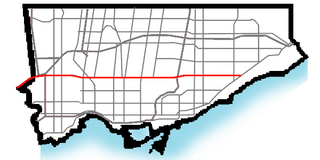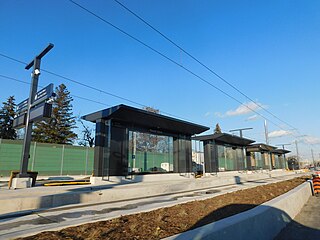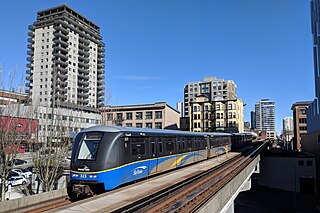King's Highway 403, or simply Highway 403, is a 400-series highway in the Canadian province of Ontario that travels between Woodstock and Mississauga, branching off from and reuniting with Highway 401 at both ends and travelling south of it through Hamilton and Mississauga. It is concurrent with the Queen Elizabeth Way (QEW) for 22 km (14 mi) from Burlington to Oakville. The Highway 403 designation was first applied in 1963 to a short stub of freeway branching off the QEW, and the entire route was completed on August 15, 1997, when the section from Brantford to the then-still independent Town of Ancaster was opened to traffic. The section of Highway 403 between Woodstock and Burlington was formally dedicated as the Alexander Graham Bell Parkway on April 27, 2016, in honour of Alexander Graham Bell.

MiWay, also known as Mississauga Transit and originally as Mississauga Transit Systems, is the municipal public transport agency serving Mississauga, Ontario, Canada, and is responsible to the city's Transportation and Works Department. MiWay services consist of two types of bus routes: MiLocal, local buses that make frequent stops, and MiExpress, express buses between major destinations. MiWay is the primary operator along the Mississauga Transitway, a dedicated east–west bus-only roadway.

Brampton Transit (BT) is a public transport bus operator for the City of Brampton in the Regional Municipality of Peel, and within the Greater Toronto Area (GTA) in Ontario, Canada. Brampton Transit began operations in 1974. In 2023, the system had a ridership of 49,200,800, or about 219,500 per weekday as of the fourth quarter of 2023.

Eglinton Avenue is a major east–west arterial thoroughfare in Toronto and Mississauga in the Canadian province of Ontario. The street begins at Highway 407 at the western limits of Mississauga, as a continuation of Lower Baseline in Milton. It traverses the midsection of both cities and ends at Kingston Road. Eglinton Avenue is the only street to cross all six former cities and boroughs of Metropolitan Toronto.

Hurontario Street is a roadway running in Ontario, Canada between Lake Ontario at Mississauga and Lake Huron's Georgian Bay at Collingwood. Within Peel Region, it is a major urban thoroughfare within the cities of Mississauga and Brampton, which serves as the divide from which cross-streets are split into East and West, except at its foot in the historic Mississauga neighbourhood of Port Credit. Farther north, with the exception of the section through Simcoe County, where it forms the 8th Concession, it is the meridian for the rural municipalities it passes through. In Dufferin County, for instance, parallel roads are labelled as EHS or WHS for East of Hurontario Street.

The Mississauga Transitway is a bus rapid transit (BRT) system in Mississauga, Ontario, Canada. It comprises a series of purpose-constructed bus-only roadways, as well as reserved lanes on existing city streets and portions of Highway 403, that together form a continuous 18 km (11 mi) route spanning most of the city from Winston Churchill Boulevard in the west to the junction of Highways 401 and 427 in the east on the border with Toronto. Service on the Transitway is provided by MiWay and GO Transit, with some stations providing connections to Brampton Transit and Toronto Transit Commission (TTC) bus services.

Metrolinx is a Crown agency of the Government of Ontario that manages and integrates road and public transport in the Greater Toronto and Hamilton Area (GTHA), which comprises much of Ontario's Golden Horseshoe region. Headquartered at Union Station in Toronto, the agency was created as the Greater Toronto Transportation Authority on June 22, 2006. The agency adopted its present name as a brand name in 2007 and eventually as the legal name in 2009.

Line 6 Finch West, also known as the Finch West LRT, is a light rail line under construction in Toronto, Ontario, Canada, to be operated by the Toronto Transit Commission. The 10.3-kilometre (6.4 mi), 18-stop line is to extend from Finch West station on Line 1 Yonge–University to the North Campus of Humber College in Etobicoke. The line will operate in a dedicated above-ground right-of-way, much of it within Finch Avenue, segregated from street traffic. The line will use transit signal priority and standard gauge rather than the broad Toronto gauge. The line is forecast to carry about 14.6 million rides a year or 40,000 a day by 2031 and will replace the 36B Finch West bus route, which is one of the three busiest bus routes in Toronto. Line 6 was expected to open within the first half of 2024, with an estimated cost of CA$2.5 billion. For budget purposes, the TTC made the assumption that Line 6 would open no earlier than September 2024. However, the builder, Mosaic Transit Group, expects the line to open by the end of 2024.
MoveOntario 2020 was a 2007 plan proposed by the Government of Ontario that would fund 52 rapid-transit projects throughout the Greater Toronto and Hamilton Area in Ontario, Canada. It was succeeded by The Big Move and GO Transit's Go 2020.

Square One Bus Terminal is a GO Transit intercity bus terminal located in central Mississauga, Ontario, Canada. It is situated directly across Rathburn Road West from the City Centre Transit Terminal and the Square One Shopping Centre.

The Hurontario LRT is a light rail line under construction in the cities of Mississauga and Brampton, Ontario, Canada. The line will run along Hurontario Street from Mississauga's Port Credit neighbourhood north to Steeles Avenue in Brampton. The line will be built and operated as a public-private partnership by Mobilinx, a consortium of private European and Japanese companies, with provincial transit agency Metrolinx retaining ownership of the line. It will be the only street railway operating in the Greater Toronto Area outside Toronto proper.

Viscount station is the northerly terminus of the Terminal Link automated people mover serving Toronto Pearson International Airport in Mississauga, Ontario, Canada. It is located on the south side of Viscount Road, between American Drive and Highway 409.

Renforth, referred to during planning as Renforth Gateway, is a bus station on the border of the cities of Mississauga and Toronto, in Ontario, Canada. Located at Eglinton Avenue and Renforth Drive, it is the eastern terminus of the Mississauga Transitway and is close to the interchange between Highway 401 and Highway 427.

502 Züm Main is a bus rapid transit route in Brampton, Ontario which leads south into Mississauga, Ontario. The second corridor, which began service on September 6, 2011, runs from Sandalwood Parkway in the city's north end to MiWay's City Centre Transit Terminal near the Square One Shopping Centre in the south. It travels via the Downtown Brampton and Brampton Gateway terminals along Main and Hurontario Streets through Brampton and Mississauga. It covers the route of current route 2, which has frequent rush-hour service. Route 502 extends and replace MiWay's route 102 InterCity Express. It runs every 10 minutes during rush hours and 20 minutes off-peak hours, including weekends. Route 2's rush hour frequency was reduced to 20 minutes to optimize ridership.
Dundas Street bus rapid transit is a proposed bus rapid transit (BRT) corridor proposed by Metrolinx for the western part of the Greater Toronto and Hamilton Area in Southern Ontario, Canada. It is part of the regional transportation plan The Big Move. Metrolinx currently refers to the project as Dundas bus rapid transit without the word "Street". The City of Mississauga used the brand Dundas Connects during the development phase.

Burnhamthorpe Road is a major arterial road in the cities of Toronto and Mississauga, Ontario; beginning at Dundas Street, near Islington Avenue, running west and becoming a rural road in the Town of Oakville, where it terminates at Tremaine Road, where it changes name.
The Big Move is a regional transportation plan (RTP) published in 2008 and consisting of 62 rapid transit projects to be implemented across the Greater Toronto and Hamilton Area (GTHA). These rapid transit projects are intended to form a seamlessly integrated regional rapid transit network, which is the first priority action in the regional transportation plan. These projects form two long-term templates with 15 and 25 year horizons. These templates outline broad projects; specific details about technology, alignment, stations and service levels for each project are subsequently determined though a cost–benefit analysis or an environmental assessment process.

Urban rail transit in Canada encompasses a broad range of rail mass transit systems, including commuter rail, rapid transit, light rail, and streetcar systems.
The Pearson Regional Transit Centre also known as Union Station West is a proposed second intermodal transportation hub to serve the Greater Toronto Area. The transit hub will be located at the site of Viscount station currently serving the Link Train across from Toronto Pearson International Airport in Mississauga, Ontario. The transit hub will be accommodated with a new passenger and processing facility known as Terminal New. It will handle functions such as check-in, security screenings and baggage claim. The transit hub will also be at the centre of a new mixed-used area including office, retail and commercial space. The plan is to bring Line 5 Eglinton, Line 6 Finch West, the Mississauga Transitway, the Kitchener line and the Union Pearson Express together into the transit hub and it will relieve Union Station. The transit centre is planned to open in the early 2030s.




















